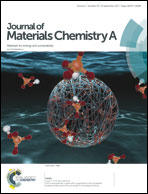Transformation of homobimetallic MOFs into nickel–cobalt phosphide/nitrogen-doped carbon polyhedral nanocages for efficient oxygen evolution electrocatalysis†
Abstract
The rational design and engineering of metal–organic frameworks (MOFs) with a hollow structure and complex compositions has attracted increasing research interest due to their importance in various applications. Herein, we develop a facile way for in situ transformation of cobalt-based homobimetallic zeolitic imidazolate framework polyhedra (NiCo-ZIF PHs) into nickel–cobalt phosphide/nitrogen-doped carbon polyhedral nanocages (NiCoP/NC PHCs) via tannic acid etching as well as calcination and phosphidation processes. Impressively, the hollow structure of polyhedral nanocages formed after the etching process is robust enough to endure the subsequent thermal treatment. The as-obtained NiCoP/NC PHCs are endowed with a large surface area and abundant pore volume, leading to the exposure of more active sites and rapid mass transfer. Besides, the guest metal Ni is homogeneously incorporated into the host CoP crystal lattice without phase segregation, which effectively modulates the electronic structures. Benefiting from the above advantages, the NiCoP/NC PHCs exhibit obviously improved electrocatalytic activity towards the OER, with a low overpotential of 297 mV to afford a current density of 10 mA cm−2 and excellent long-term stability. Moreover, the present synthetic route is easy to scale up, which is especially appealing for practical application.



 Please wait while we load your content...
Please wait while we load your content...